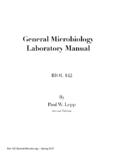Transcription of Management of Veterinary Laboratories Code - …
1 Chapter Management of Veterinary Laboratories outlines the overall requirements and responsibilities to be addressed in the Management of Veterinary Laboratories , of which Management of the biological risks associated with the operation of a laboratory is an important aspect. This chapter outlines the principles on which the specific Management of biological risks associated with Veterinary Laboratories and experimental animal handling facilities should be based. The terminology is aligned with the OIE nomenclature for risk analysis, including the four components, namely hazard identification, risk assessment, risk Management and risk communication, used in Chapter Import Risk Analysis of both the OIE Terrestrial Animal Health Code and OIE Aquatic Animal Health Code.
2 In this way the process is consistent with and standardised against risk analysis processes already used by OIE Member Countries. Adoption of the risk analysis approach to Management of biological risks for biosafety and biosecurity in Veterinary Laboratories and animal facilities provides Member Countries with a means of tailoring their relevant national animal health policies and procedures regarding their Laboratories to their particular circumstances and priorities. The biological risk Management approach gives countries a mechanism to protect their human and animal populations from inadvertent or intentional release of or exposure to animal pathogens in an evidence-based, transparent, economically viable and sustainable manner. The approach is applicable in all countries from technologically advanced to in-transition or resource-limited countries.
3 The risk analysis approach moves towards a comprehensive biological risk Management framework that is science-based and specific to an individual country and laboratory s circumstances. The process could accommodate the assigning of pathogens to risk groups relevant to the country and the subsequent restriction of the associated work to laboratory facilities defined by containment levels tailored to the types of risk identified if this suits an individual country s requirements as identified by its biological risk analysis. This chapter and the associated Chapter Managing biorisk: examples of aligning risk Management strategies with assessed biorisks provide the framework for implementation of the risk Management approach. Veterinary Laboratories and animal facilities routinely handle biological materials that may constitute or contain infectious agents and toxins that may cause adverse animal or public health and economic effects due to uncontrolled release inside or outside the laboratory .
4 laboratory and animal facilities managers are responsible for providing a Management system that ensures safe and secure handling, storage, and transport of these biological materials (a biological risk Management system). This is needed not only to protect laboratory workers from inadvertent exposures and infection, but also to protect the local and regional animal populations, human populations, and environment from accidental or intentional release and spread of biological agents and toxins from Laboratories . These considerations should also apply to animals and potential arthropod vectors that are handled in Veterinary Laboratories and animal facilities. The term biological material is used throughout this chapter to include all potential sources of biological risk for which laboratory Management may be responsible.
5 To classify the potential biological risk posed by the presence and handling of a particular biological material, laboratory managers should apply a systematic and evidence-based approach. Biological risk analysis is the process of identifying and characterising health, safety, and security risks, followed by implementing, measuring the effectiveness of, and communicating the control measures used to reduce those risks to acceptable levels. Risk analysis has been used effectively by individuals in business and finance, engineering, energy, and health industries to characterise and control inherent risks associated with their business practices. This chapter focuses on biological-related risks, recognising that additional health and safety concerns exist, and should be controlled within the laboratory environment, such as radiation exposures, chemical burns, or liquid nitrogen hazards.
6 A laboratory biological risk Management system includes the policies, responsibilities, and operational procedures used to support biological risk analysis and the resulting biosafety and laboratory biosecurity measures implemented to manage laboratory biological risks. Additional definitions and further explanation of the risk analysis principles and associated laboratory biological risk Management system approach presented in this chapter can be found in the OIE Handbook on Import Risk Analysis for Animals and Animal Products and in the European Committee for Standardization (CEN) Workshop Agreement on laboratory Biorisk Management . Following the overview presented in this chapter, a general guide for performing a risk analysis is included in Appendix The types of biological hazards to be considered, the associated risks and the types of Management strategies to be considered are provided in a table in Appendix Chapter contains worked examples based on hypothetical scenarios of how the checklist can be worked through for specific infectious hazards.
7 As outlined in Chapter Management of Veterinary Laboratories , it is a standard for Member Countries having such facilities that they be managed within the context of a formally stated animal health policy that indicates clearly the purposes for which laboratory services are required. This animal health policy typically includes specific mention of the disease agents for which a diagnostic or research capability is required and allows for the subsequent design and development of a laboratory capability that is fit for purpose. The design of the laboratory capability will guide decisions regarding the use or avoidance of particular direct and indirect laboratory test methods that may involve the handling, propagation, and storage of particular infectious agents or toxins in the laboratory .
8 This process should be expected to result in a list of the biological materials, including each specific infectious agent that will be held by the laboratory . Biological risk assessments are undertaken to inform and determine the policy and procedures that in turn give confidence that the laboratory procedures for each of the biological materials handled by the laboratory pose negligible danger to a country s animal and human populations. The assessments of biological risk are usually taken at a national or jurisdictional level and may lead to national or jurisdictional standards or regulations for biological risk Management that are followed by all Veterinary Laboratories and animal handling facilities in that country or jurisdiction. Agencies and Laboratories responsible for biological risk analysis may make use of data, information and guidance available in published technical documents such as specific chapters of the OIE Terrestrial Animal Health Code, the Aquatic Animal Health Code and this Terrestrial Manual as well as publications from other internationally recognised bodies and organisations.
9 It is the intention of this chapter to provide countries and Laboratories with a process that can be applied when developing standards, policies and procedures appropriate to their particular circumstances. It is additionally a requirement that the process be transparent to other Member Countries that may have a legitimate interest in the effectiveness of the Management of laboratory biological risks in the particular country. Although this chapter is applicable to Veterinary Laboratories and animal handling facilities, it is noted that in the international context, issues that have an impact on public health are also subject to binding international agreement. Consequently, the Veterinary biological risk analysis process must deliver outcomes in support of the particular country s obligations regarding zoonotic diseases, such as under the World Health Organization (WHO) International Health Regulations (IHR) (WHO, 2005).
10 For countries in the process of developing their national standard, this chapter provides guidance for identifying and assessing the country s animal health risks and related laboratory Management strategies. laboratory biosafety describes the principles and practices for the prevention of unintentional release of or accidental exposure to biological agents and toxins. laboratory biosecurity describes the physical control of biological agents and toxins within Laboratories , in order to prevent their loss, theft, misuse, unauthorised access or intentional unauthorised release. These and other terms are defined in the Glossary of this Terrestrial Manual. laboratory risk assessments are used to identify the specific biosafety and biosecurity measures needed to contain and work safely with specific biological agents and toxins in a laboratory or animal facility.













